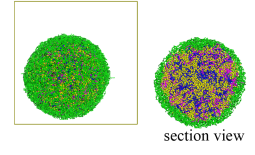[1] Immordino, M. L.; Brusa, P.; Arpicco, S.; Stella, B.; Dosio, F.; Cattel, L. J. Controlled Release 2003, 91(3), 417.
[2] Yang, Y.; Wang, J.-C.; Zhang, X.; Lu, W.-L.; Zhang, Q. J. Controlled Release 2009, 135(2), 175.
[3] Straubinger, R. M.; Balasubramanian, S. V. Methods in Enzymology, Vol. 391, 2005, p. 97.
[4] Chen, Y.; Zhao, Y.; Liu, Q.-Q.; Zou, J. China Pharmacy 2011, 22(2), 130. (陈瑶, 赵银, 刘青青, 邹俊, 中国药房, 2011, 22(2), 130.)
[5] Gaucher, G.; Dufresne, M. H.; Sant, V. P.; Kang, N.; Maysinger, D.; Leroux, J. C. J. Controlled Release 2005, 109(1-3), 169.
[6] Yu, S.-F.; Gu, X.; Wu, G.-L.; Wang, Z.; Wang, Y.-N.; Gao, H.; Ma, J.-B. Acta Chim. Sinica 2012, 70(2), 177. (于树芳, 顾鑫, 伍国琳, 王铮, 王亦农, 高辉, 马建标, 化学学报, 2012, 70(2), 177.)
[7] Zheng, X.-L.; Ding, A.-S.; Luo, D.; Gao, H.-S. Acta Chim. Sinica 2012, 70(1), 92. (郑兴良, 丁爱顺, 罗丹, 高鸿盛, 化学学报, 2012, 70(1), 92.).
[8] Yang, Z.-L.; Li, X.-R.; Yang, K.-W.; Liu, Y. Acta Chim. Sinica 2007, 65(19), 2169. (杨卓理, 李馨汝, 杨可伟, 刘艳, 化学学报, 2007, 65(19), 2169.)
[9] Mao, J.; Gan, Z.-H. Chem. J. Chin. Univ. 2009, 30(11), 2291. (毛静, 甘志华, 高等学校化学学报, 2009, 30(11), 2291.).
[10] Tran, V. T.; Karam, J. P.; Garric, X.; Coudane, J.; Benoit, J. P.; Montero-Menei, C. N.; Venier-Julienne, M. C. Eur. J. Pharm. Sci. 2012, 45(1-2), 128.
[11] Vey, E.; Rodger, C.; Meehan, L.; Booth, J.; Claybourn, M.; Miller, A. F.; Saiani, A. Polym. Degrad. Stab. 2012, 97(3), 358.
[12] Alconcel, S. N. S.; Baas, A. S.; Maynard, H. D. Polym. Chem. 2011, 2(7), 1442.
[13] Menz, B.; Knerr, R.; Gopferich, A.; Steinem, C. Biomaterials 2005, 26(20), 4237.
[14] Bluemmel, J.; Perschmann, N.; Aydin, D.; Drinjakovic, J.; Surrey, T.; Lopez-Garcia, M.; Kessler, H.; Spatz, J. P. Biomaterials 2007, 28(32), 4739.
[15] Xie, Y.; Liu, M.-F.; Zhou, J. Appl. Surf. Sci. 2012, 258(20), 8153.
[16] Gref, R.; Minamitake, Y.; Peracchia, M. T.; Trubetskoy, V.; Torchilin, V.; Langer, R. Science 1994, 263(5153), 1600.
[17] Ukawala, M.; Rajyaguru, T.; Chaudhari, K.; Manjappa, A. S.; Pimple, S.; Babbar, A. K.; Mathur, R.; Mishra, A. K.; Murthy, R. S. R. Drug Delivery 2012, 19(3), 155.
[18] Mothe, C. G.; Azevedo, A. D.; Drumond, W. S.; Wang, S. H.; Sinisterra, R. D. J. Therm. Anal. Calorim. 2011, 106(3), 671.
[19] Li, T.-H.; Han, R.-Y.; Wang, M.-Z.; Liu, C.-B.; Jing, X.-B.; Huang, Y.-B. Macromol. Biosci. 2011, 11(11), 1570.
[20] Zhang, W.-L.; Li, Y.-L.; Liu, L.-X.; Sun, Q.-Q.; Shuai, X.-T.; Zhu, W.; Chen, Y.-M. Biomacromolecules 2010, 11(5), 1331.
[21] Jain, R. A. Biomaterials 2000, 21(23), 2475.
[22] Veronese, F. M.; Pasut, G. Drug Discovery Today 2005, 10(21), 1451.
[23] Mallarde, D.; Boutignon, F.; Moine, F.; Barre, E.; David, S.; Touchet, H.; Ferruti, P.; Deghenghi, R. Int. J. Pharm. 2003, 261(1-2), 69.
[24] Davaran, S.; Rashidi, M. R.; Pourabbas, B.; Dadashzadeh, M.; Haghshenas, N. M. Int. J. Nanomed. 2006, 1(4), 535.
[25] Mo, S. M.; Oh, I. J. J. Nanosci. Nanotechnol. 2011, 11(2), 1795.
[26] Pamujula, S.; Hazari, S.; Bolden, G.; Graves, R. A.; Chinta, D. D.; Dash, S.; Kishore, V.; Mandal, T. K. J. Pharm. Pharmacol. 2012, 64(1), 61.
[27] Ashjari, M.; Khoee, S.; Mahdavian, A. R.; Rahmatolahzadeh, R. J. Mater. Sci.: Mater. Med. 2012, 23(4), 943.
[28] Liu, H.-L.; Hu, Y. CIESC J. 2003, 54(4), 440. (刘洪来, 胡英, 化工学报, 2003, 54(4), 440.)
[29] Feng, J.; Liu, H.-L.; Hu, Y. J. Nanjing Univ. Technol. 2005, 27(2), 105. (冯剑, 刘洪来, 胡英, 南京工业大学学报, 2005, 27(2), 105.)
[30] Xia, J.; Zhong, C.-L. Macromol. Rapid Commun. 2006, 27, 1110.
[31] Zhong, C.-L.; Liu, D.-H. Macromol. Theory Simul. 2007, 16, 141.
[32] Liu, D.-H.; Zhong, C.-L. Polymer 2008, 49(5), 1407.
[33] Xin, J.; Liu, D.-H.; Zhong, C.-L. J. Phys. Chem. B 2009, 113(28), 9364.
[34] Feng, J.; Ge, X.-T.; Shang, Y.-Z.; Zhou, L.-H.; Liu, H.-L.; Hu, Y. Fluid Phase Equilib. 2011, 302, 26.
[35] Guo, H.-Y.; Cui, J.-M.; Sun, D.-L.; Zhou, J. CIESC J. 2012, 11, 3707. (郭泓雨, 崔洁铭, 孙德林, 周健, 化工学报, 2012, 11, 3707.)
[36] Guo, X.-D.; Zhang, L.-J.; Qian, Y.; Zhou, J. Chem. Eng. J. 2007, 131, 195.
[37] Posocco, P.; Fermeglia, M.; Pricl, S. J. Mater. Chem. 2010, 20, 7742.
[38] Rodriguez-Hidalgo, M. D. R.; Soto-Figueroa, C.; Vicente, L. Soft Matter 2011, 7, 8224.
[39] Masoud, H.; Alexeev, A. ACS Nano 2012, 6, 212.
[40] Groot, R. D.; Warren, P. B. J. Chem. Phys. 1997, 107(11), 4423.
[41] Groot, R. D.; Madden, T. J. J. Chem. Phys. 1998, 108(20), 8713.
[42] Groot, R. D.; Rabone, K. L. Biophys. J. 2001, 81(2), 725.
[43] Maiti, A.; McGrother, S. J. Chem. Phys. 2004, 120(3), 1594.
[44] Sun, D.-L.; Zhou, J. Acta Phys.-Chim. Sin. 2012, 28(4), 909. (孙德林, 周健, 物理化学学报, 2012, 28(4), 909.)
[45] Zhuang, Q.-X.; Xue, Z.-J.; Liu, X.-Y.; Yuan, Y.-L.; Han, Z.-W. Polym. Compos. 2011, 32(10), 1671.
[46] Zhao, Y.; You, L.-Y.; Lu, Z.-Y.; Sun, C.-C. Polymer 2009, 50(22), 5333.
[47] Xie, X.-A.; Ding, N.-P.; Liu, H.-B.; Zheng, L.-S.; Xiong, M.-Z. Acta Chim. Sinica 2011, 69(2), 169. (解新安, 丁年平, 刘焕彬, 郑璐丝, 熊明洲, 化学学报, 2011, 69(2), 169.)
[48] Fan, B.-Y.; Fan, Y.-L.; Hu, S.-J.; Sun, L.; Li, M.; Li, Q.; Ji, Y.-B. Chin. Pharm. J. 2011, 46, 1220. (范兵羽, 范玉玲, 胡淑娟, 孙黎, 李淼, 李强, 季宇彬, 中国药学杂志, 2011, 46, 1220.)



